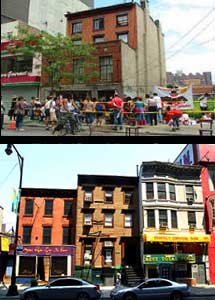
City Council members at a hearing yesterday criticized a $500,000 report commissioned by the city’s Economic Development Corporation (EDC) that found no conclusive evidence to support claims that seven houses along Duffield and Gold streets in Downtown Brooklyn were involved in Underground Railroad activities.
...
Their houses are in the footprint of a planned 1-acre park and underground parking garage that would be used by the upscale Aloft and Sheraton hotels across the street, as well as surrounding office tenants. EDC Vice President Thomas McKnight called the parcel a “signature piece of the Downtown Brooklyn plan” but stopped short of saying it was critical.
He said an eminent domain hearing on the homes is scheduled for May 22. The City Council has no power to prevent the seizure of the homes.
The Eagle story goes into the details of how AKRF, the same firm that produced the Atlantic Yards Environmental Impact Study, got the contract for the Duffield St. report, how experts cited in the study found the study to be flawed and why archeologists weren't hired to investigate evidence of tunnels connecting the homes.

The Brooklyn Paper, Council takes up ‘Railroad’ fight
The battle over whether the Underground Railroad passed through seven houses on Duffield and Gold streets made it this week to the City Council, which could block a city plan to destroy the houses for a hotel parking lot.
...
So the EDC paid a Park Avenue consulting firm, AKRF, a half-million dollars to research the historic value of the properties — and specifically their ties to the Underground Railroad.
On Tuesday, an AKRF vice president, Linh Do, said the Underground Railroad did, indeed, make more stops in Brooklyn than the Q train — but the company’s researchers found no link between the seven houses and the Abolitionist movement.
“Bulls—t!” one Duffield Houses supporter said in a far-from-quiet stage whisper.
The Brooklyn Paper (Editorial), Save the Duffield Seven!
In our never-ending rush to make a buck, New York has knocked down, paved over and torn apart virtually all of its pre-colonial and Revolutionary history. When tourists come to the city, they see our soaring monuments to modern money-making, but precious little of the historic relics that could explain why this city was so vital to its earliest European settlers in the first place.
It would be a tragedy if this is allowed to happen on Duffield Street, whose houses remain a powerful reminder of how slavery touched — and built — New York City.
...
A museum on Duffield Street would celebrate history. Destroying the houses desecrates it.
